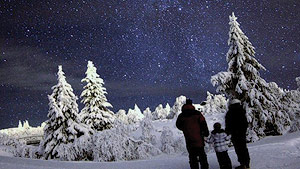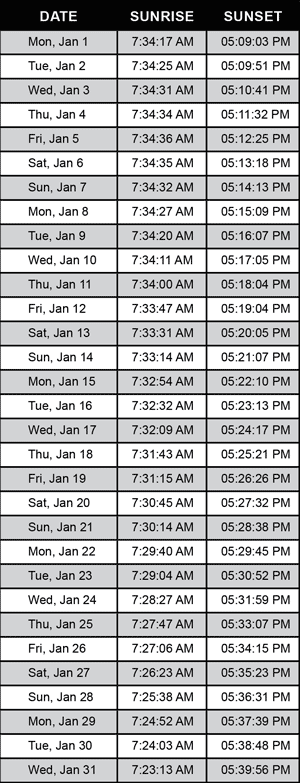|
|
DARK SKY HAPPENINGS - January 2024
Moab
UT (at City Hall)
38O34’ N Latitude
109O33’ W Longitude
4048 ft - 1234 m |
Winter Stargazing Tips: Stay Warm and Cozy
 Snow, cold, wind...one thing is guaranteed to warm an astronomer’s heart in these frigid winter nights: the sparking skies! Orion, Taurus, the Pleiades, Sirius, the Andromeda Galaxy, and the Double Custer in Perseus are just a few of the gorgeous sights at their peak in the winters of the Northern Hemisphere. But, how can you observe comfortably when the weather seems determined to turn you into a popsicle? Snow, cold, wind...one thing is guaranteed to warm an astronomer’s heart in these frigid winter nights: the sparking skies! Orion, Taurus, the Pleiades, Sirius, the Andromeda Galaxy, and the Double Custer in Perseus are just a few of the gorgeous sights at their peak in the winters of the Northern Hemisphere. But, how can you observe comfortably when the weather seems determined to turn you into a popsicle?
1. Layers are your friend!
Layer up! A warm coat won’t help that much if all you are wearing underneath is a t-shirt. Or, moving around during your observing may heat you up, so being able to peel off a layer would be welcome.
2. Accessorize
Wear your gloves, hat, socks, and boots! Some astronomers prefer fingerless gloves, while others prefer combo mitten-gloves. A hat with ear flaps? Big fuzzy earmuffs? While they may feel silly, you will be in the dark. Who cares what you look like? Finally, thick wool socks will help, especially if you are wearing good boots!
3. Clear out your observing area
Is snow on the ground where you usually set up? Clear it away. Your equipment and toes will thank you.
4. Blankets
Did you bring a blanket? Good. You very well may want one, especially if you are sitting.
5. Heat pads
Heating pads may be rechargeable, rice, or chemical. Whatever you use, if you follow the instructions, they’ll be your friend in your pockets, gloves, or boots on a cold night.
6. A warm thermos
A thermos full of your favorite warm liquid—hot chocolate, soup, coffee, tea—is your best friend during long winter nights.
One final thing to remember: someone somewhere is in an even colder place. Though January is the warmest time of year in Antarctica, it’s still cold! NASA kicked off its annual Antarctic Long Duration Balloon Campaign in December. Three stadium-sized balloons will support five missions with one vying to break NASA’s balloon flight record, which stands just over 55 days. Follow online: https://www.csbf.nasa.gov/antarctica/payloads.htm
This article is distributed by the NASA Night Sky Network, a coalition of hundreds of astronomy clubs across the US dedicated to astronomy outreach.
Visit nightsky.jpl.nasa.gov to find local clubs, events, stargazing info and more.
Sunrise-Sunset
(The time of sunrise and sunset assumes a flat horizon. Actual time may
vary depending upon the landscape.) |
 |
MOON HAPPENINGS
January 3 - Third Quarter at 8:30 pm January 11 - New Moon at 4:57 am January 17 - First Quarter at 8:52 pm January 25 - Full Moon at 10:54 am
|
Moab Dark Skies mission is to promote the appreciation and conservation of Moab’s valuable and rare dark skies. Moab Dark Skies was established by the Friends of Arches and Canyonlands Parks in conjunction with the National Park Service and Utah State Parks Division of Natural Resources
For more information, check out our
Facebook page |
|
|
|
|
|
|
|
© 2002-2024 Moab Happenings. All rights
reserved.
Reproduction of information contained in this site is
expressly prohibited.
|
|